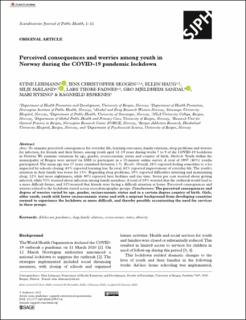| dc.contributor.author | Lehmann, Stine | |
| dc.contributor.author | Skogen, Jens Christoffer | |
| dc.contributor.author | Haug, Ellen | |
| dc.contributor.author | Mæland, Silje | |
| dc.contributor.author | Fadnes, Lars Thore | |
| dc.contributor.author | Sandal, Gro Mjeldheim | |
| dc.contributor.author | Hysing, Mari | |
| dc.contributor.author | Bjørknes, Ragnhild | |
| dc.date.accessioned | 2023-02-15T08:30:29Z | |
| dc.date.available | 2023-02-15T08:30:29Z | |
| dc.date.created | 2021-03-01T14:26:33Z | |
| dc.date.issued | 2021 | |
| dc.identifier.citation | Lehmann, S., Skogen, J. C., Haug, E., Mæland, S., Fadnes, L. T., Sandal, G. M., ... & Bjørknes, R. (2021). Perceived consequences and worries among youth in Norway during the COVID-19 pandemic lockdown. Scandinavian Journal of Public Health, 49(7), 755-765. | en_US |
| dc.identifier.issn | 1403-4948 | |
| dc.identifier.uri | https://hdl.handle.net/11250/3050917 | |
| dc.description.abstract | Aims: To examine perceived consequences for everyday life, learning outcomes, family relations, sleep problems and worries for infection, for friends and their future, among youth aged 12–19 years during weeks 7 to 9 of the COVID-19 lockdown in Norway. We examine variations by age, gender, socioeconomic status and country of birth. Methods: Youth within the municipality of Bergen were invited via SMS to participate in a 15-minute online survey. A total of 2997 (40%) youths participated. The mean age was 17 years (standard deviation 1.7). Results: Overall, 28% reported feeling somewhat to a lot impacted by schools closing, 63% reported learning less. In total, 62% reported improvement of everyday life. The youth’s situation in their family was worse for 13%. Regarding sleep problems, 19% reported difficulties initiating and maintaining sleep, 12% had more nightmares, while 90% reported later bedtime and rise time. Seven per cent worried about getting infected, while 53% worried about infection among family members. A total of 19% worried that the outbreak would lead to a more difficult future, and 32%worried that friends were facing a difficult situation at home. Perceived consequences and worries related to the lockdown varied across sociodemographic groups. Conclusions: The perceived consequences and degree of worries varied by age, gender, socioeconomic status and to a certain degree country of birth. Girls, older youth, youth with lower socioeconomic status and with a migrant background from developing countries seemed to experience the lockdown as more difficult, and thereby possibly accentuating the need for services in these groups. | en_US |
| dc.language.iso | eng | en_US |
| dc.publisher | Sage | en_US |
| dc.rights | Navngivelse 4.0 Internasjonal | * |
| dc.rights.uri | http://creativecommons.org/licenses/by/4.0/deed.no | * |
| dc.title | Perceived consequences and worries among youth in Norway during the COVID-19 pandemic lockdown | en_US |
| dc.type | Peer reviewed | en_US |
| dc.type | Journal article | en_US |
| dc.description.version | publishedVersion | en_US |
| dc.rights.holder | The authors | en_US |
| dc.subject.nsi | VDP::Samfunnsvitenskap: 200 | en_US |
| dc.subject.nsi | VDP::Medisinske Fag: 700 | en_US |
| dc.source.journal | Scandinavian Journal of Public Health | en_US |
| dc.identifier.doi | 10.1177/1403494821993714 | |
| dc.identifier.cristin | 1894582 | |
| cristin.ispublished | true | |
| cristin.fulltext | original | |
| cristin.qualitycode | 1 | |

